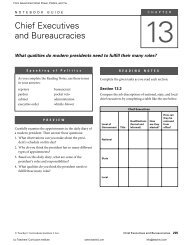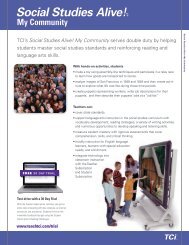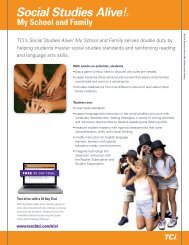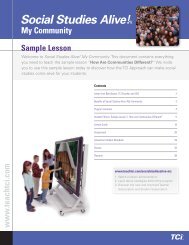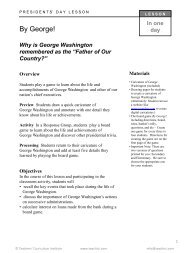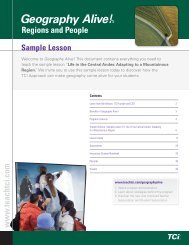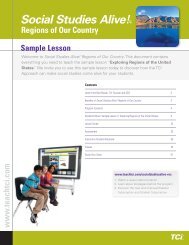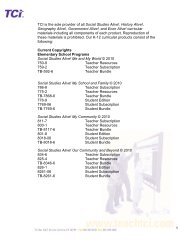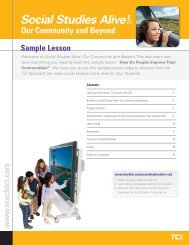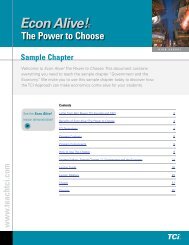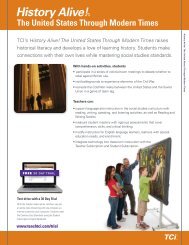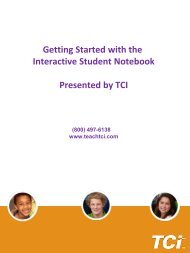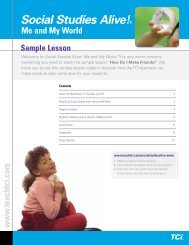Social Studies Alive! Skill Builder Chapter - TCI
Social Studies Alive! Skill Builder Chapter - TCI
Social Studies Alive! Skill Builder Chapter - TCI
- No tags were found...
You also want an ePaper? Increase the reach of your titles
YUMPU automatically turns print PDFs into web optimized ePapers that Google loves.
Methods to Transform Elementary Instruction(c) Teachers' Curriculum Institute www.teachtci.com info@teachtci.com
Multiple Intelligence Teaching Strategy<strong>Social</strong> <strong>Studies</strong> <strong>Skill</strong> <strong>Builder</strong>Steps at a Glance12345Use <strong>Social</strong> <strong>Studies</strong> <strong>Skill</strong><strong>Builder</strong>s to engage andinspire your students.Teach the skill throughmodeling and guidedpractice.Prepare students towork in pairs.Set clear expectations,allow students to practicethe skill repeatedly,and give immediatefeedback.Debrief the lessonto help students makeconnections to keysocial studies concepts.<strong>Social</strong> studies skills—such as reading maps, categorizing information, analyzingartifacts and primary resources, comparing and contrasting ideas, reading fordetail, summarizing the main idea in writing, and interpreting historicaldocuments—are vital to a student’s success in middle and high school. Sadly,by the time your students reach the secondary level, their teachers may be sohard-pressed to cover content that they rarely have time to teach skills. Youcan prepare your students for success by giving them a strong foundation inthe skills they will need to master more difficult content in middle and highschool. Because they are fun, engaging, and fast-paced, <strong>Social</strong> <strong>Studies</strong> <strong>Skill</strong><strong>Builder</strong>s will allow you to begin teaching these skills as soon as students enterkindergarten.In this strategy, students work in pairs to complete skill-oriented tasks. Youbegin each activity by quickly modeling the skill and then challenging studentsto practice that skill again and again. As students work, you give them immediatefeedback. The activity ends with a debriefing session that allows students touse their new skill to make connections to key social studies concepts.36 <strong>Social</strong> <strong>Studies</strong> <strong>Alive</strong>!(c) Teachers' Curriculum Institute www.teachtci.com info@teachtci.com
S T E P1Use <strong>Social</strong> <strong>Studies</strong> <strong>Skill</strong> <strong>Builder</strong>s to engage andinspire your students.Teaching the skills elementary students will need to be successfulin social studies courses during their secondary school careers mayseem daunting. Using <strong>Social</strong> <strong>Studies</strong> <strong>Skill</strong> <strong>Builder</strong>s, you can turn this formidablechallenge into fun, interactive lessons that both you and your students will enjoy.The first step is to appreciate these unique features of <strong>Social</strong> <strong>Studies</strong> <strong>Skill</strong> <strong>Builder</strong>s:Students sit in pairs to solve skill-oriented problems. Working with just onepartner gives each student more opportunity to talkand be involved than when working in a group.In this <strong>Social</strong> <strong>Studies</strong> <strong>Skill</strong><strong>Builder</strong>, lower-elementarystudents practice the socialskills of talking and listening.Each task challenges students to use multipleintelligences. For example, in a lesson about how fiveracial and ethnic groups—Native Americans, Latinos,European Americans, African Americans, and AsianAmericans—came to America and contributed tothe country’s growth and development, students readabout each group, draw images and symbols to representeach group’s experience, create a collage of theimages, and write a verse that relates to each group.Each skill is introduced quickly, and students arechallenged to practice it repeatedly. Active involvementis the key to success.Students are told exactly how their mastery of theskill will be assessed. For example, during an activityin which students analyze artifacts related to public services—such as drawingsof a fire hose, fire hydrant, ax, and fire helmet to represent fire fighting—studentsmust carefully write about what they think each artifact is, what it is usedfor, who would use it, and what public service it is related to. Students are givenimmediate feedback on each artifact they analyze. This pushes them to workquickly and creates a game-like atmosphere.Each skill is taught at a developmentally appropriate level. If a skill is introducedthoughtfully, elementary students can master fairly complex topics soonerthan you might expect. For example, lower-elementary students can learn how tounderstand perspective in a map if you begin by identifying objects in the classroomand then tell a story about a mouse that crawls to the top of the shelves andlooks down upon the classroom. Using the idea of the mouse’s perspective, studentsare then challenged to interpret a map of the classroom. In this way, youngstudents learn basic map skills, which they will use for the rest of their lives.“Students enjoy <strong>Social</strong><strong>Studies</strong> <strong>Skill</strong> <strong>Builder</strong>sbecause they get to workwith someone and theactivities are fast-paced—they don’t realize how muchwork they are actuallydoing. And I really appreciatethat these are gradableactivities without takehomepaperwork for me.”<strong>Social</strong> <strong>Studies</strong> <strong>Skill</strong> <strong>Builder</strong> 37(c) Teachers' Curriculum Institute www.teachtci.com info@teachtci.com
S T E P Prepare students to work in pairs.After you have modeled the skill, it’s time to place students in pairs.3Because they will be discussing skill-oriented questions that havediscrete answers, working in pairs is ideal. Students will have moreopportunity for interaction and won’t get off track as easily as they might in alarger group. Here are some tips for preparing students to work in pairs:Arrange students in mixed-ability pairs. Since these skill tasks require the use ofmultiple intelligences, it makes sense to pair students with complementary abilities.This will help ensure that each partner has something of value to contribute,and that interaction is more equitable. For an activity that requires linguisticand visual skills, for example, try to put a strong linguistic student with one whoexcels visually. This process may take a half hour, but it is time well spent as itwill result in students working together much more harmoniously.Before class, prepare a transparency showing where students will sit. Create amap showing the arrangement of desks or tables in your classroom or, for youngerstudents, the location of the rug or community area. To limit distractions, spacedesks evenly around the classroom. Use an erasable marker to write students’names next to the desks at which you want them to work. This will help studentsmove efficiently into pairs and will reinforce geography skills, especially if youadd a compass rose to your map. Use the transparency as a template for your next<strong>Social</strong> <strong>Studies</strong> <strong>Skill</strong> <strong>Builder</strong>.Instruct students to sit side by side on the rug, at tables, or with their deskstouching. Project the map for students to use as a guide in forming pairs. Tellthem they are not officially a team until they are sitting on the rug or at a tablewith their shoulders touching, or until the right edge of one desk is touching theleft edge of the other and both students are facing forward.Encourage students to greet each other. Once studentshave found their partners and are sitting correctly, tellthem to introduce themselves and shake hands. Model thisbehavior with one of your students. Smile and have funwhile you do this. This will ease tension and help pairswork together more effectively.“Some students have suchstrength in a skill neededfor the task that I makethem ‘experts’ available toother pairs for consultation.The variety of skillsneeded for <strong>Social</strong> <strong>Studies</strong><strong>Skill</strong> <strong>Builder</strong>s gives me theopportunity to use manydifferent experts, and students’self-esteem is verypositively affected.”A bit of silliness in the classroomwill help studentsfeel comfortable and worktogether effectively.Conduct a quick team-builder to warm up students forworking together. This might be as simple as having studentslook directly into their partners’ eyes as they, withconviction and spirit, say, “Buddy, if you need a helpinghand, you can count on me!” and give each other a highfive.You might also ask them to discuss a question relatingto the skill being taught. For example, before an activityon public services, you might ask partners to share whichof four public service jobs—teacher, firefighter, judge, orpolice officer—they would most like to have and why.<strong>Social</strong> <strong>Studies</strong> <strong>Skill</strong> <strong>Builder</strong> 39(c) Teachers' Curriculum Institute www.teachtci.com info@teachtci.com
Making Your Job EasierYou might create cardsfolded to show three surfaces—coloredred, yellow, andgreen—and have groupssignal their current workingcondition by flipping theircard. Green means “We’refine, making progress.”Yellow means “We have aquestion, but we’ll continueto try to solve our ownproblem.” Red means “Wehave finished our task andneed to be checked butwill continue to read andresearch while waiting.”This encourages studentsto make wise use of theirtime and to take responsibilityfor helping themselveslearn.Checking work as studentsproceed through theactivity helps keep studentson task.S T E P4Set clear expectations, allow studentsto practice the skill repeatedly, and giveimmediate feedback.After you have quickly modeled the skill and placed students inmixed-ability pairs, clearly state what you expect from them so you can evaluatetheir work fairly. An easy and efficient way to do this is to create a transparencythat tells students exactly what is expected of them. You may want to award pointsfor each part of an assignment your students successfully complete.Checking work and awarding points as students progress through the activity willmotivate them to work quickly and conscientiously in a game-like atmosphere.It will also assure that students create high-quality products, as they know you’llbe carefully scrutinizing each answer. And it will give you a break from gradingpapers at home.The greatest challenge you will face when giving students immediate feedback ismanaging the constant, and possibly overwhelming, flow of students waiting tohave their work checked. Here are some tips to help make sure you have no morethan two or three pairs of students waiting for feedback:• Familiarize yourself with the handout in advance so you can quickly check eachstudent’s work for key points.• Have students put their fingers on the exact answer they want corrected.This will prevent your having to search the entire handout for the next answerto correct.• Give pairs more than one artifactor question to work on at a timeso they take longer to finish.• Ask students who have accuratelycompleted the activity to beresponsible for correcting theirpeers’ work.• Circulate around the classroom tocorrect handouts rather than havingstudents wait in line. Studentsmight signal they are ready foryour review by putting their pencilsdown, folding their arms, andsmiling—not by yelling for yourattention.40 <strong>Social</strong> <strong>Studies</strong> <strong>Alive</strong>!(c) Teachers' Curriculum Institute www.teachtci.com info@teachtci.com
S T E P5Debrief the lesson to help students makeconnections to key social studies concepts.Most teachers find that there comes apoint during each <strong>Social</strong> <strong>Studies</strong> <strong>Skill</strong><strong>Builder</strong> when most students, but not all, have finishedworking. It may be more effective to debriefthe activity at this point than to wait for everyoneto finish. To ensure that all your students have beenexposed to the same content, consider asking pairsto take turns reporting to the class what they discovered.A pair might interpret an artifact, explain aprimary source, or answer a geography question forthe entire class while the other students take notes tomake the information their own.After all your students have been exposed to all thecontent, it is time to challenge them to think holisticallyabout the fragmented bits of content they havelearned. Think of a way for your students to consider,as a whole, all the artifacts, questions, or primaryresources they analyzed during the <strong>Social</strong> <strong>Studies</strong> <strong>Skill</strong> <strong>Builder</strong>. Here are someactivities used to wrap up <strong>Social</strong> <strong>Studies</strong> <strong>Skill</strong> <strong>Builder</strong>s:• Write an acrostic including all the examples they analyzed. After a lesson inwhich students learn about public services by connecting a series of artifacts tospecific services, challenge them to write an acrostic using the word PUBLIC.For example, the P might introduce the line, “Police make sure people are safe.”• Write song verses about various groups in American society. After studentshave analyzed a series of readings about racial and ethnic groups in the UnitedStates, ask them to write several verses to the song “This Land Is Your Land”that identify each group’s country of origin and highlight the group’s contributionsto American society.• Create a photo journal of key geographic landmarks. After studentshave located a series of physical features on a U.S. map, have them create a“photo journal” of a trip across the states by drawing geographic landmarks(Appalachians, Great Plains, Colorado River) seen along the way.• Create a “human spectrum” evaluating the contributions of Europeanexplorers. After students have studied how ten European explorers claimed,conquered, and controlled North America, have individual students hold upa placard of each explorer and stand along a spectrum from “Explorer withMost Impact on the United States Today” to “Explorer with Least Impact onthe United States Today.”• Identify the effects of local geographic features. After students have learnedhow geography impacts human settlement around the United States, have themselect a geography topic—such as weather, elevation, natural resources, orbodies of water—that affects them locally and make a drawing showing theeffects of that topic on people’s lives.Having students groupthemselves along aspectrum helps the entireclass to think holisticallyabout the various pieces ofinformation they collectedduring the activity.“Debriefing <strong>Social</strong> <strong>Studies</strong><strong>Skill</strong> <strong>Builder</strong>s gives me achance to make sure allstudents understand theconcepts. I’ve found thatafter they have worked inpairs, they have a lot ofdetails and ideas to sharewith the class.”<strong>Social</strong> <strong>Studies</strong> <strong>Skill</strong> <strong>Builder</strong> 41(c) Teachers' Curriculum Institute www.teachtci.com info@teachtci.com



